多腺悬钩子Rubus phoenicolasius Maxim.
多腺悬钩子Rubus phoenicolasius Maxim.
种拉丁名:Rubus phoenicolasius Maxim.
种别名 :树莓(太白山)
国内分布:产山西、河南、陕西、甘肃、山东、湖北、 四川。生低海拔至中海拔的林下、路旁或山沟谷底。日本,朝鲜,欧洲,北美也有分布。据文献和,中国高等植物图盘,秦岭植物志。中记载,青海、江苏、湖北、湖南、贵州也有分布:但均末见到标本。
海 拔:生于低海拔低海拔林下、路旁等。
命名来源:[Bull.Acad.Sci;St。Pdtersb. 17: 160. 1872]
中国植物志:37:066
英文植物志:9:212
亚组中文名:绒毛叶亚组
亚组拉丁名:Subsect.Stimuiantes
组中文名:空心莓组
组拉丁名:Sect.ldaeobatus Focke
属中文名:悬钩子属
属拉丁名:Rubus
亚科中文名:蔷薇亚科
亚科拉丁名:ROSOideae Pocke
科中文名:蔷薇科
科拉丁名:Rosaceae
纲中文名:双子叶植物纲
纲拉丁名:DICOTYLEDONEAE
门中文名:被子植物门
门拉丁名:ANGIOSPERMAE
形态特征:灌木,高1—3米;枝初直立后蔓生,密生红褐色刺毛、腺毛和稀疏皮刺。小叶3枚,稀 5枚,卵形、宽卵形或菱形,稀椭圆形,长4—8(10)厘米,宽2—5(7)厘米,顶端急尖至渐 尖,基部圆形至近心形,上面或仅沿叶脉有伏柔毛,下面密被灰白色绒毛,沿叶脉有刺毛、 腺毛和稀疏小针刺,边缘具不整齐粗锯齿,常有缺刻,顶生小叶常浅裂;叶柄长3—6厘米, 小叶柄长2—3厘米,侧生小叶近无柄,均被柔毛、红褐色刺毛、腺毛和稀疏皮刺;托叶线 形,具柔毛和腺毛.花较少数,形成短总状花序,顶生或部分腋生;总花梗和花梗密被柔 毛、刺毛和腺毛;花梗长;5-15毫米;苞片披针形;具柔毛和腺毛;花直径6—10毫米;花萼 外面密被柔毛,刺毛和腺毛;萼片披针形,·顶端尾尖;长1-1.5,厘米,在花果期均直立开 展;花瓣直立,倒卵状匙形或近圆形,紫红色,基部具爪并有柔毛;雄蕊稍短于花柱;花柱比 雄蕊稍长,子房无毛或微具柔毛。果实半球形,直径约1厘米,红色,无毛,核有明显皱纹 与洼穴。 花期5-6月,果期-7-8月。
用 途:果微酸可食; 根,叶入药;可解毒及作强壮剂;茎皮可提取栲胶
产地分布:产山西、河南、陕西、甘肃、山东、湖北、 四川。生低海拔至中海拔的林下、路旁或山沟谷底。日本,朝鲜,欧洲,北美也有分布。据文献和,中国高等植物图盘 :秦岭植物志。中记载,青海、江苏、湖北、湖南、贵州也有分布:但均末见到标本。
本种提示:本种和库页悬钩子 R.sachamensis levl 区别在于后者花梗和花萼真钎刺和腺毛;花白色等果实具绒毛;但本种花梗和花萼具刺毛、腺毛和小皮刺;花紫红色;果实无毛。
参考文献:Rubus phoenieolasius Maxim.In Bull.Acad.Sci;St。Pdtersb.17:160.1872(M61。Bi01.8:392.1872);Focke in Engler,Bot。Jahrb.29:400。1900 el in 1.C。36(Beihl.82):55.1905;id.·Bibl.Bot 72(2):191.1911;Nakai in F1.Sylv.Kor.7:70.L 28.1918; Rehd. In 了ourn. Arn. Arb. 5: 197.·1924; Heslop-Harrisort in F[. Europ· 2: 101968;中国高等植物图鉴2:280.图2290.1972;秦岭植物志1(2):538;1974。
亚组概述:Subsect.Stimuiantes:Yu et.Lu,.植物分类学报20(3):299.1982.-Sect.Pungentes Focke,Bibl.Bot.72(2):160;1911 et,83:40. 1914·P.P. -Sect。Ldaeanthi Focke,L c.72(2):171.1911,et 83:·43.1914.P.P。 本亚组有下列13种。
《Flora of China》 Vol. 9 (2003)
Rubus phoenicolasius Maximowicz
多腺悬钩子 duo xian xuan gou zi
Shrubs 1–3 m tall. Branches upright at first, finally scrambling, densely pubescent, with intermixed reddish brown bristles, stalked glands, and sparse prickles. Leaves imparipinnate, 3-foliolate, rarely 5-foliolate; petiole 3–6 cm, petiolule of terminal leaflet 2–3 cm, lateral leaflets subsessile, petiolule and rachis pubescent, with intermixed reddish brown bristles, stalked glands, and sparse prickles; stipules linear, 5–8 mm, pubescent, with intermixed glandular hairs; blade of leaflets ovate, broadly ovate, or rhombic, rarely elliptic, 4–8(–10) × 2–5(–7) cm, abaxially densely gray tomentose, bristly, stipitate glandular, with sparse, minute needle-like prickles, adaxially appressed pubescent or pubescent only along veins, base rounded to subcordate, margin irregularly rough serrate, usually incised, terminal leaflet often lobed, apex acute to acuminate. Inflorescences terminal or axillary, short racemes, few flowered, terminal racemes 6–10 cm, lateral ones shorter; rachis, pedicels, and abaxial surface of calyx densely pubescent, bristly, stipitate glandular; bracts lanceolate, 5–8 mm, pubescent, stipitate glandular, margin entire or apically 2-lobed. Pedicel 0.5–1.5 cm. Flowers 6–10 mm in diam. Sepals erect, lanceolate, 1–1.5 cm × 4–7 mm, apex caudate. Petals purplish red, obovate-spatulate or suborbicular, much longer than sepals, base long clawed and pubescent. Stamens many, nearly as long as or slightly shorter than petals. Pistils somewhat longer than stamens; ovary glabrous or puberulous. Aggregate fruit orange or red, subglobose, ca. 1 cm in diam., glabrous; pyrenes prominently rugose, pitted. Fl. May–Jun, fr. Jul–Aug. 2n = 14.
Roadsides, montane valleys. Low to medium elevations. Gansu, Henan. Hubei, Qinghai, Shaanxi, Shandong, Shanxi, Sichuan [Japan, Korea; naturalized in Europe and North America].
别名:wine raspberry;树莓;腺刺萼悬钩子;紫毛悬钩子;白里叶莓;大红眼儿;里白梅;黏托盘;
科名:蔷薇科 Rosaceae
属名:悬钩子属 Rubus

种拉丁名:Rubus phoenicolasius Maxim.
种别名 :树莓(太白山)
国内分布:产山西、河南、陕西、甘肃、山东、湖北、 四川。生低海拔至中海拔的林下、路旁或山沟谷底。日本,朝鲜,欧洲,北美也有分布。据文献和,中国高等植物图盘,秦岭植物志。中记载,青海、江苏、湖北、湖南、贵州也有分布:但均末见到标本。
海 拔:生于低海拔低海拔林下、路旁等。
命名来源:[Bull.Acad.Sci;St。Pdtersb. 17: 160. 1872]
中国植物志:37:066
英文植物志:9:212
亚组中文名:绒毛叶亚组
亚组拉丁名:Subsect.Stimuiantes
组中文名:空心莓组
组拉丁名:Sect.ldaeobatus Focke
属中文名:悬钩子属
属拉丁名:Rubus
亚科中文名:蔷薇亚科
亚科拉丁名:ROSOideae Pocke
科中文名:蔷薇科
科拉丁名:Rosaceae
纲中文名:双子叶植物纲
纲拉丁名:DICOTYLEDONEAE
门中文名:被子植物门
门拉丁名:ANGIOSPERMAE
形态特征:灌木,高1—3米;枝初直立后蔓生,密生红褐色刺毛、腺毛和稀疏皮刺。小叶3枚,稀 5枚,卵形、宽卵形或菱形,稀椭圆形,长4—8(10)厘米,宽2—5(7)厘米,顶端急尖至渐 尖,基部圆形至近心形,上面或仅沿叶脉有伏柔毛,下面密被灰白色绒毛,沿叶脉有刺毛、 腺毛和稀疏小针刺,边缘具不整齐粗锯齿,常有缺刻,顶生小叶常浅裂;叶柄长3—6厘米, 小叶柄长2—3厘米,侧生小叶近无柄,均被柔毛、红褐色刺毛、腺毛和稀疏皮刺;托叶线 形,具柔毛和腺毛.花较少数,形成短总状花序,顶生或部分腋生;总花梗和花梗密被柔 毛、刺毛和腺毛;花梗长;5-15毫米;苞片披针形;具柔毛和腺毛;花直径6—10毫米;花萼 外面密被柔毛,刺毛和腺毛;萼片披针形,·顶端尾尖;长1-1.5,厘米,在花果期均直立开 展;花瓣直立,倒卵状匙形或近圆形,紫红色,基部具爪并有柔毛;雄蕊稍短于花柱;花柱比 雄蕊稍长,子房无毛或微具柔毛。果实半球形,直径约1厘米,红色,无毛,核有明显皱纹 与洼穴。 花期5-6月,果期-7-8月。
用 途:果微酸可食; 根,叶入药;可解毒及作强壮剂;茎皮可提取栲胶
产地分布:产山西、河南、陕西、甘肃、山东、湖北、 四川。生低海拔至中海拔的林下、路旁或山沟谷底。日本,朝鲜,欧洲,北美也有分布。据文献和,中国高等植物图盘 :秦岭植物志。中记载,青海、江苏、湖北、湖南、贵州也有分布:但均末见到标本。
本种提示:本种和库页悬钩子 R.sachamensis levl 区别在于后者花梗和花萼真钎刺和腺毛;花白色等果实具绒毛;但本种花梗和花萼具刺毛、腺毛和小皮刺;花紫红色;果实无毛。
参考文献:Rubus phoenieolasius Maxim.In Bull.Acad.Sci;St。Pdtersb.17:160.1872(M61。Bi01.8:392.1872);Focke in Engler,Bot。Jahrb.29:400。1900 el in 1.C。36(Beihl.82):55.1905;id.·Bibl.Bot 72(2):191.1911;Nakai in F1.Sylv.Kor.7:70.L 28.1918; Rehd. In 了ourn. Arn. Arb. 5: 197.·1924; Heslop-Harrisort in F[. Europ· 2: 101968;中国高等植物图鉴2:280.图2290.1972;秦岭植物志1(2):538;1974。
亚组概述:Subsect.Stimuiantes:Yu et.Lu,.植物分类学报20(3):299.1982.-Sect.Pungentes Focke,Bibl.Bot.72(2):160;1911 et,83:40. 1914·P.P. -Sect。Ldaeanthi Focke,L c.72(2):171.1911,et 83:·43.1914.P.P。 本亚组有下列13种。
《Flora of China》 Vol. 9 (2003)
Rubus phoenicolasius Maximowicz
多腺悬钩子 duo xian xuan gou zi
Shrubs 1–3 m tall. Branches upright at first, finally scrambling, densely pubescent, with intermixed reddish brown bristles, stalked glands, and sparse prickles. Leaves imparipinnate, 3-foliolate, rarely 5-foliolate; petiole 3–6 cm, petiolule of terminal leaflet 2–3 cm, lateral leaflets subsessile, petiolule and rachis pubescent, with intermixed reddish brown bristles, stalked glands, and sparse prickles; stipules linear, 5–8 mm, pubescent, with intermixed glandular hairs; blade of leaflets ovate, broadly ovate, or rhombic, rarely elliptic, 4–8(–10) × 2–5(–7) cm, abaxially densely gray tomentose, bristly, stipitate glandular, with sparse, minute needle-like prickles, adaxially appressed pubescent or pubescent only along veins, base rounded to subcordate, margin irregularly rough serrate, usually incised, terminal leaflet often lobed, apex acute to acuminate. Inflorescences terminal or axillary, short racemes, few flowered, terminal racemes 6–10 cm, lateral ones shorter; rachis, pedicels, and abaxial surface of calyx densely pubescent, bristly, stipitate glandular; bracts lanceolate, 5–8 mm, pubescent, stipitate glandular, margin entire or apically 2-lobed. Pedicel 0.5–1.5 cm. Flowers 6–10 mm in diam. Sepals erect, lanceolate, 1–1.5 cm × 4–7 mm, apex caudate. Petals purplish red, obovate-spatulate or suborbicular, much longer than sepals, base long clawed and pubescent. Stamens many, nearly as long as or slightly shorter than petals. Pistils somewhat longer than stamens; ovary glabrous or puberulous. Aggregate fruit orange or red, subglobose, ca. 1 cm in diam., glabrous; pyrenes prominently rugose, pitted. Fl. May–Jun, fr. Jul–Aug. 2n = 14.
Roadsides, montane valleys. Low to medium elevations. Gansu, Henan. Hubei, Qinghai, Shaanxi, Shandong, Shanxi, Sichuan [Japan, Korea; naturalized in Europe and North America].

